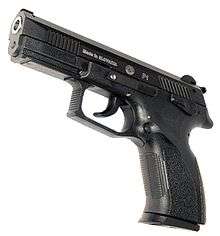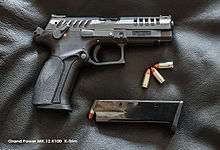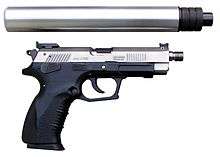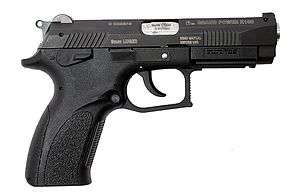Grand Power K100
| K100 | |
|---|---|
|
Grand Power K100 Mark 6 | |
| Type | Semi-automatic pistol |
| Place of origin |
|
| Production history | |
| Designer | Jaroslav Kuracina |
| Designed | 1994–1996 |
| Manufacturer | Grand Power |
| Produced | 2002–present |
| Variants | K100 Tactical, K100 Mark 6, K100 DAO, K100 QA, K100 Target, GPC9, K100 Whisper, K102 R, K105 R, P1 |
| Specifications | |
| Weight | 740 g (26 oz) |
| Length | 202.5 mm (7.97 in) |
| Barrel length | 108 mm (4.3 in) |
| Width | 40 mm (1.6 in) |
| Height | 133.5 mm (5.3 in) |
|
| |
| Cartridge | 9×19mm Parabellum |
| Action | Short recoil operated, rotating barrel |
| Feed system | 17-round detachable box magazine |
| Sights |
Fixed, front blade and adjustable rear notch 160 mm (6.3 in) sight radius |
The K100 is a 9×19mm semi-automatic pistol designed and built by Grand Power s.r.o. in Banská Bystrica, Slovakia.
Development
The K100 was developed by Jaroslav Kuracina, a former weapons officer in the Slovak Army. Kuracina sketched drawings of the K100 as early as 1992, but manufacturing activities were highly restricted during the early post-Communist era. Kuracina would be forced to wait until 1996 to continue development of his design. In 2007 Grand Power announced a deal to produce 100,000 units for the U.S. market in partnership with Texas-based handgun manufacturer STI International Inc.[1][2] The first pistols were exported in 2008. They were K100 Mk6 pistols under the commercial name GP 6.
Design details




The K100 uses a rare locking system, similar in some ways to the Beretta Cougar, Px4 Storm, and Brügger & Thomet MP9 which employs a rotating barrel lock, which in the K100's case is cammed by a cross pin. When the pistol is fired the barrel and slide move backward together for about 3/8 of an inch while the barrel is cammed clockwise (with respect to the shooter) by a flat, twisting, helical "cut" in the barrel extension. Once the barrel and slide have moved back to the point where the barrel has twisted about 45°, the slide is free to continue traveling back while the barrel's travel is arrested by its interface to the frame via the barrel extension's square shoulders. On the K100, the Beretta's barrel extension cam cut, and transfer block's cam tooth, are replaced by a curled, twisting cut in the barrel extension, and a round, frame-embedded cross-pin respectively. As such, there is no transfer block (locking block) per se, and the barrel extension directly interfaces with the frame via the replaceable cross-pin. The design allows a low bore axis relative to the shooter's hand and avoids the use of the transfer/locking block typically found in rotating barrel pistols.
Both of the Berettas, and the K100, have the archetypal square shouldered lock protruding from the otherwise round barrel, easily visible at the ejection port with the slide fully forward. This square shoulder is rotated in behind a solid column of steel running the length of the slide forward of the ejection port, and on the left side out of view, when the slide and barrel are fully forward in battery. This locks the slide forward in battery. Given that the MP9 uses the same basic locking mechanism, and has a cyclical rate of fire of 900 rounds/min, the rotating barrel lock has shown itself to be capable of very fast lock times.
The thick walled barrel and other metal parts are treated by Tenifer QPQ technology. This hardens the metal components and increases resistance to corrosion.[3]
The standard K100 has a barrel length of 108 mm (4.3 in) and operates in both single- and double-action mode. The hammer must be manually decocked for carry in double-action mode with a chambered round. The safety can be applied with the hammer cocked, but can not be applied with the hammer in the forward position. The safety does not lock the slide. A decocking hammer group is available as an option on many models.
The ergonomically shaped polymer grip frame houses a steel receiver which provides the rails the slide travels on as well as hardpoints required for the trigger mechanism. The slide spring guide, safety, trigger, and trigger guard are polymer.
The pistol's toothy surface, and grooved grips, provide good grip even with wet hands. The K100 also features ambidextrous controls, supporting both left and right-handed users. When field stripping models made prior to 2012, the forward part of the trigger guard unlatches from the gripframe and is flexed downward out of the frame. With the forward part of the trigger guard flexed downward, the slide moves farther to the rear than normal and can be pulled to the extreme rear and then lifted up and off the frame. The field strip is roughly similar to the Walther PPK/PPKS fieldstrip except that the triggerguard is not hinged on the K100, instead its polymer construction allows it to flex downward.
Current production Grand Power pistols use a solid trigger guard and a new take down lever. They also have 4 user interchangeable grip backstraps to accommodate various hand shapes and sizes; this feature permits most shooters a comfortable and efficient grip on the firearm.
Additional models
K22S/K22 X-Trim - Two .22lr versions of the K100. The K22S has fixed sights, and the K22 X-Trim has adjustable sights. Both are manufactured on the same steel chassis and grip of the center-fire models, and have steel not zinc alloy slides. They are stand alone firearms, and not conversion kits. Using a direct blowback system rather than the rotary lock up, the rimfire barrels are dovetailed and pinned into the steel chassis.
P1 - 93 mm barrel and matching slide using the same frame.
P1S - 93 mm barrel and matching slide using the subcompact P11 frame/grip.
P11 - 85 mm barrel and matching slide with subcompact frame/grip and 12-round magazine.
X-Trim - A sporting version of the K100 with a scalloped slide and tighter fit.
Target - An adjustable-sight version of the K100 featuring a micrometric adjustable rear and fiber optic front sight.
X-Calibur - For 2012, a new model with a longer fluted bull barrel and scalloped slide was introduced. Felt recoil and front sight lift is noticeably reduced.
P40/P45 - For 2013, a new larger grip frame sized to fit the .45ACP cartridge was introduced. The P40 is chambered in .40 S&W, .357Sig, and 10mm Auto. The P45 is chambered in .45 ACP. Using the same rotary locking barrel system, and the same 108 mm barrel length, the larger-caliber guns use many of the same proven components of the 9mm models.
P40L/P45L - For 2014, a 127mm/5-inch barrel and corresponding slide model was added to the larger caliber line up.
Q100 - A striker fired version of the K100 intended primarily for armed forces and self-defense. The Q100 has a 108mm barrel and the same modular grip as the K100. The initial version will be in 9x19.[4]
References
- ↑
- ↑ STI International - GP6
- ↑ "Tenifer QPQ". Retrieved 26 October 2014.
- ↑ Grand Power Q100
External links
| Wikimedia Commons has media related to Grand Power. |
- Grandpower Homepage
- Instruction manual
- Modern Firearms
- Review of the STI GP6 (K100) from American Rifleman
